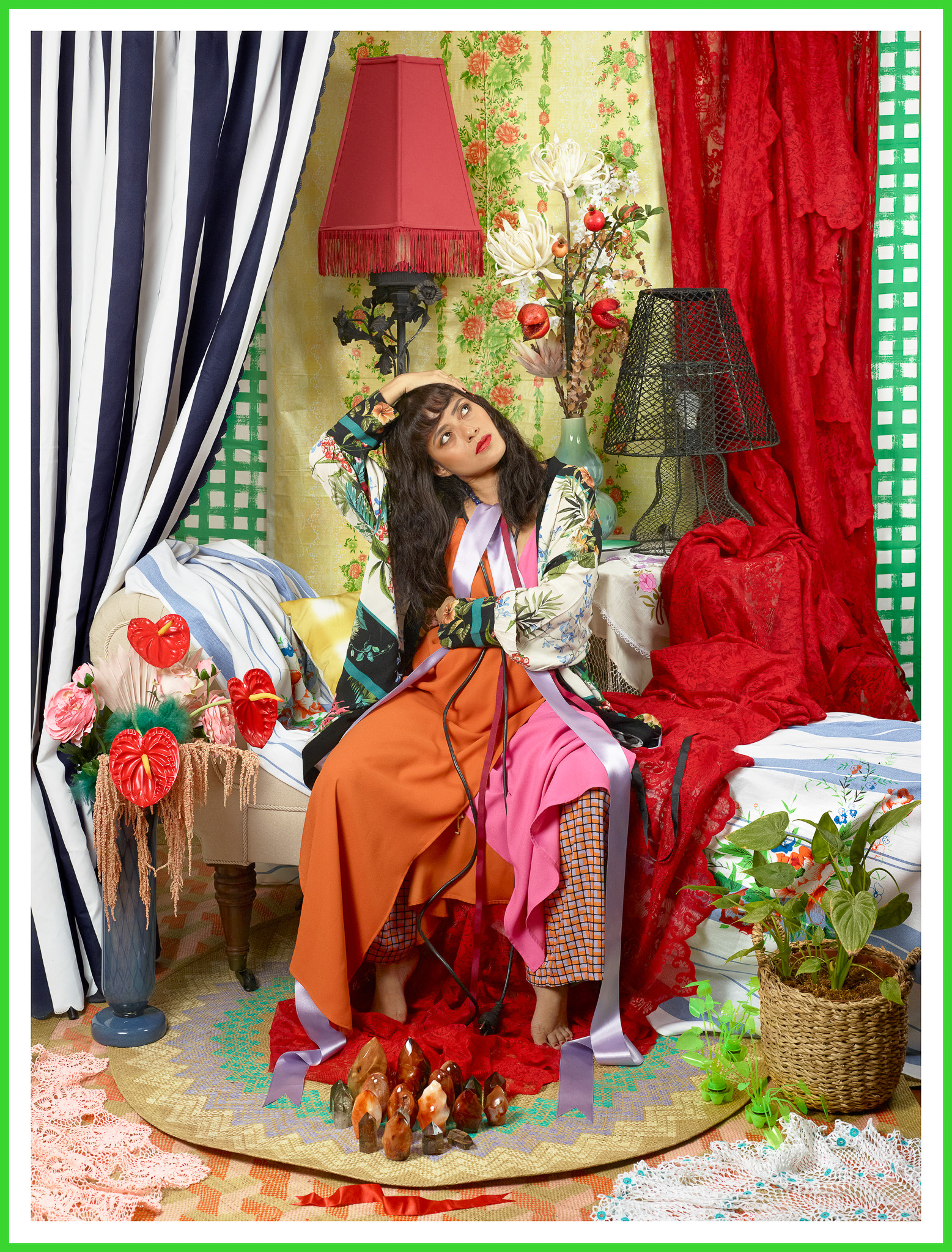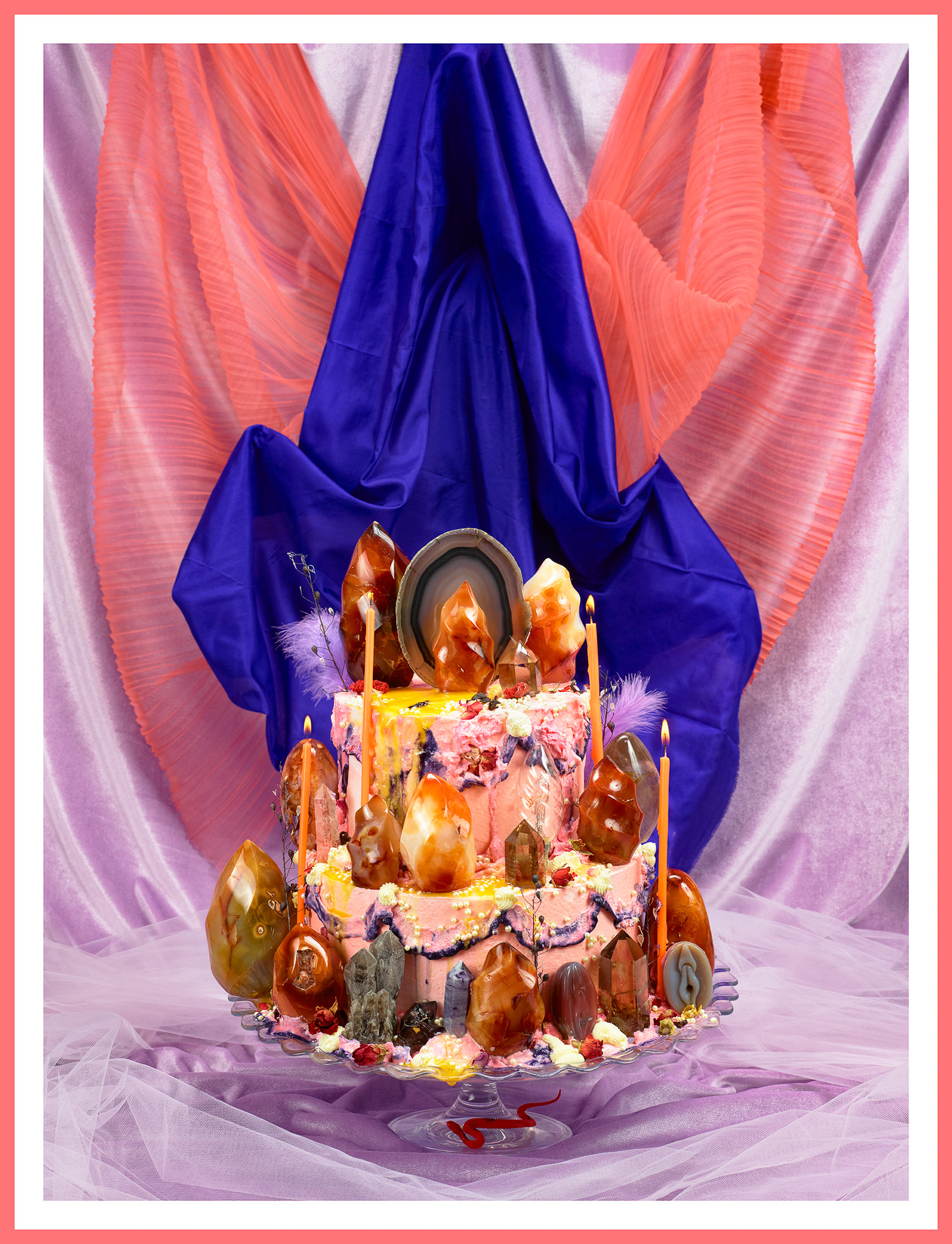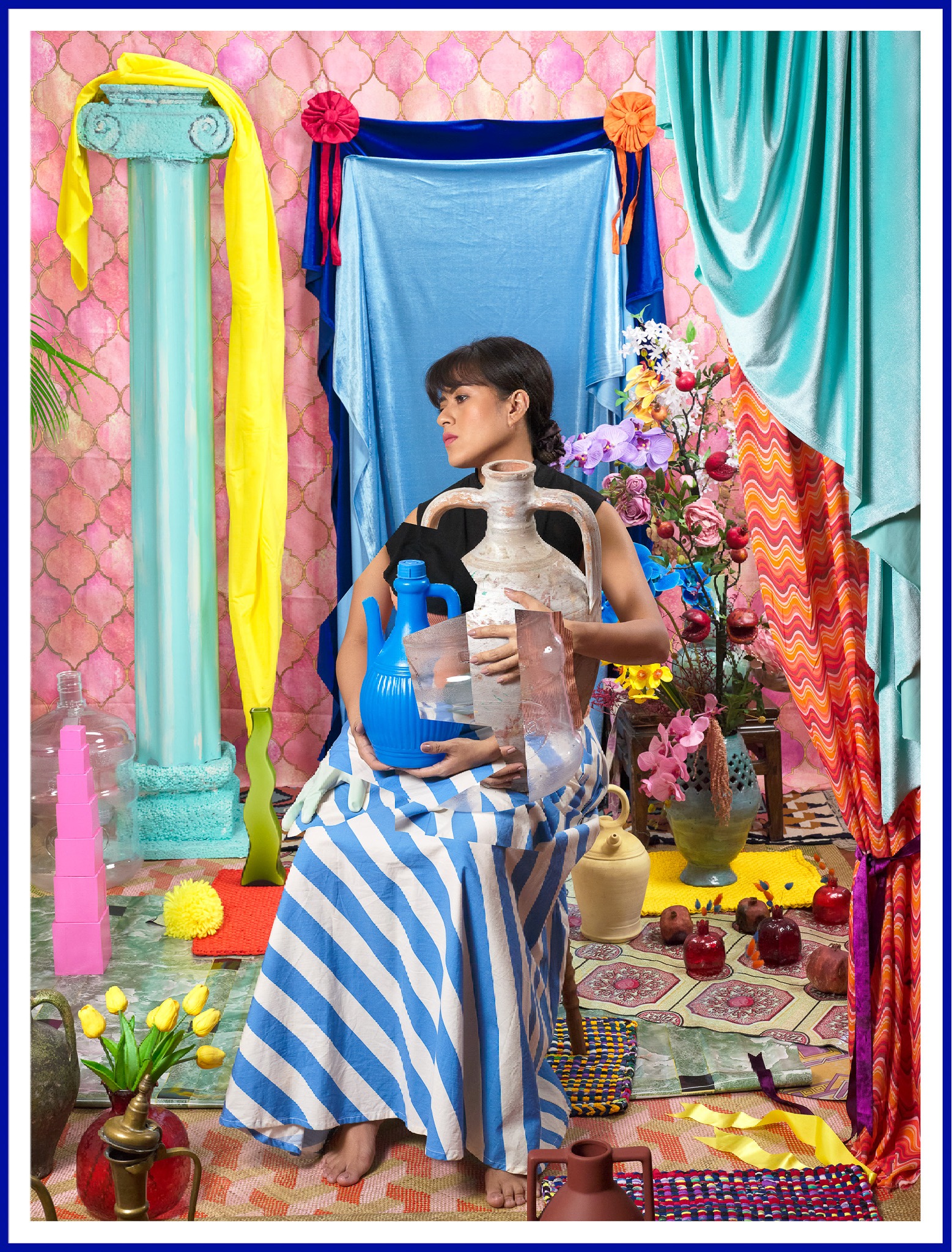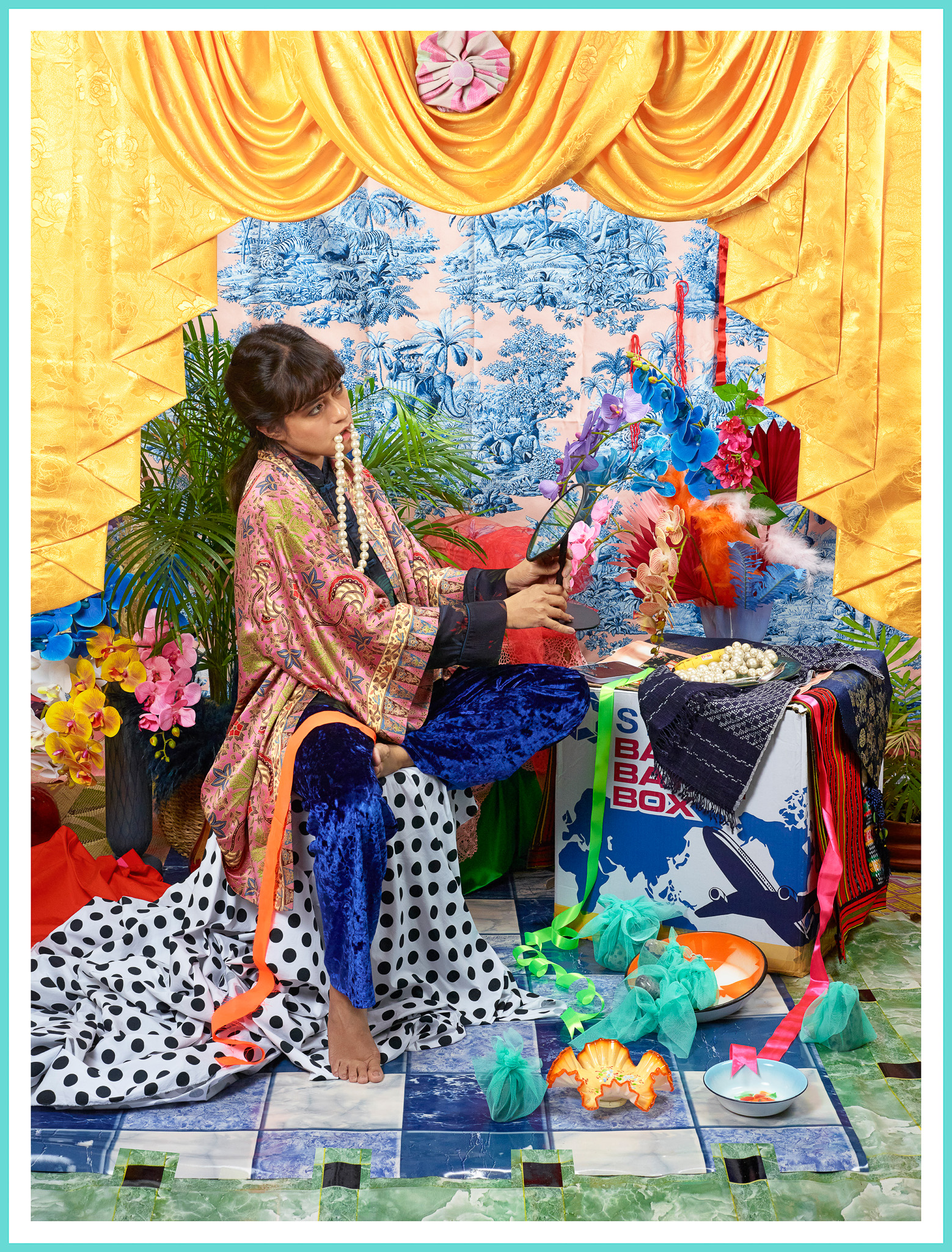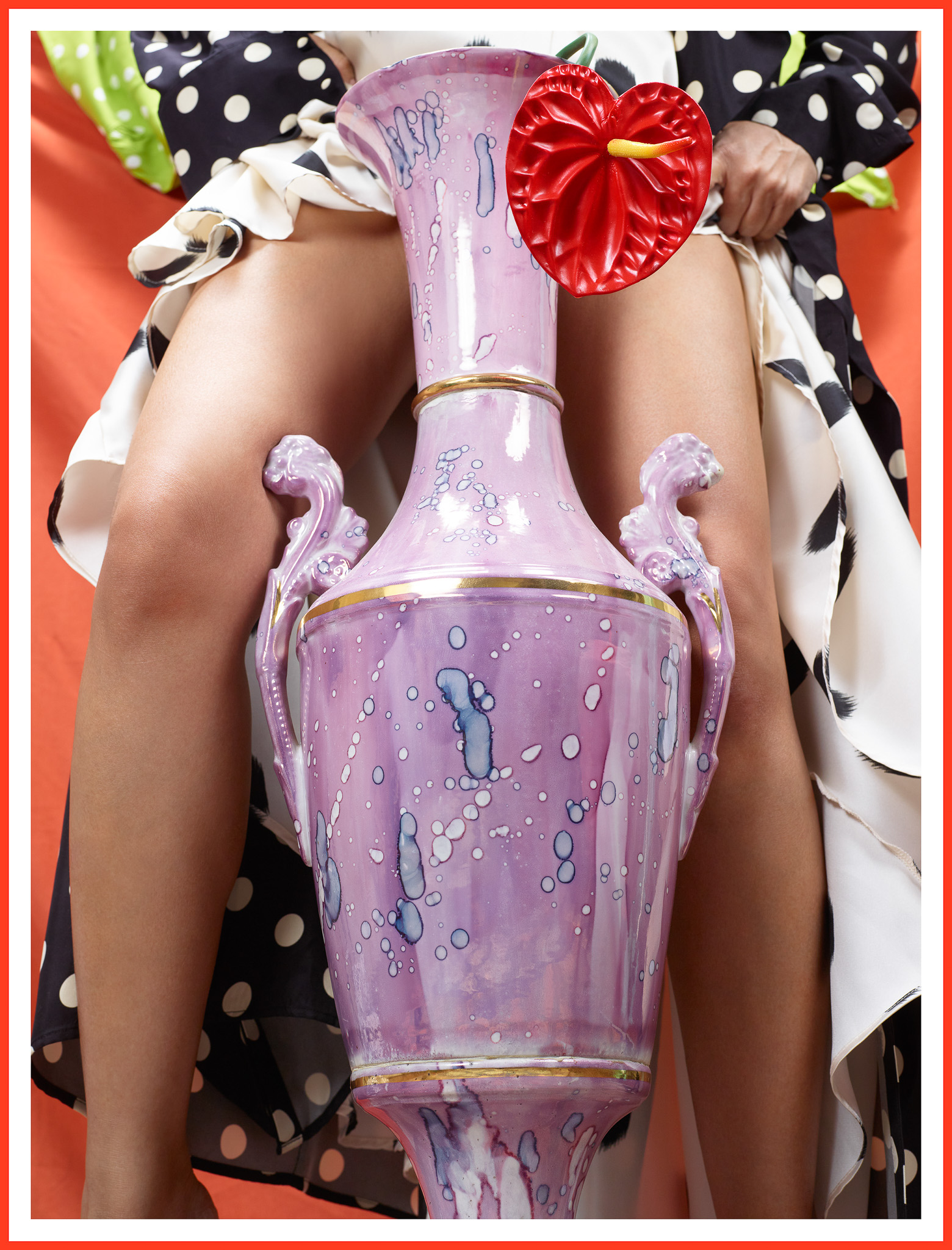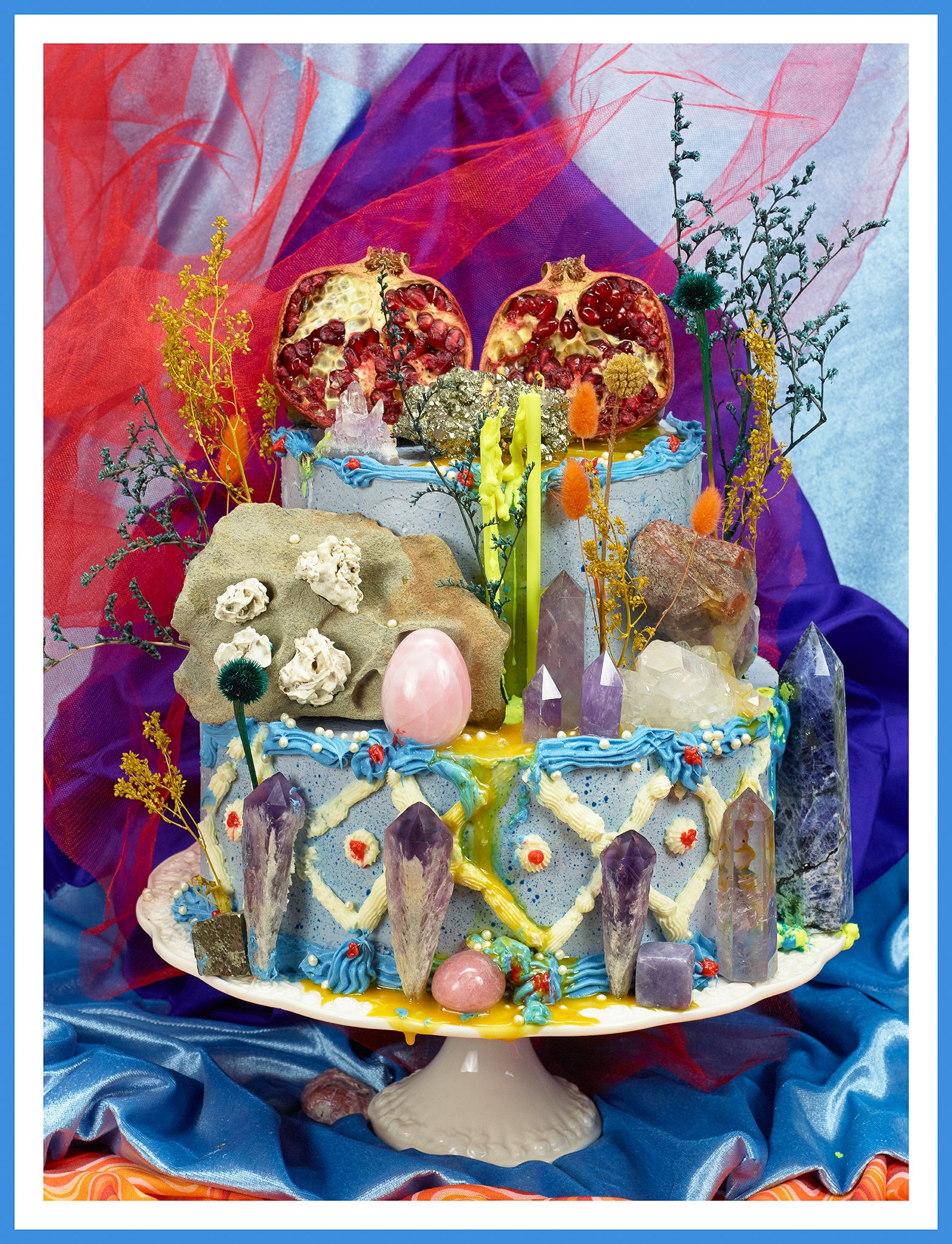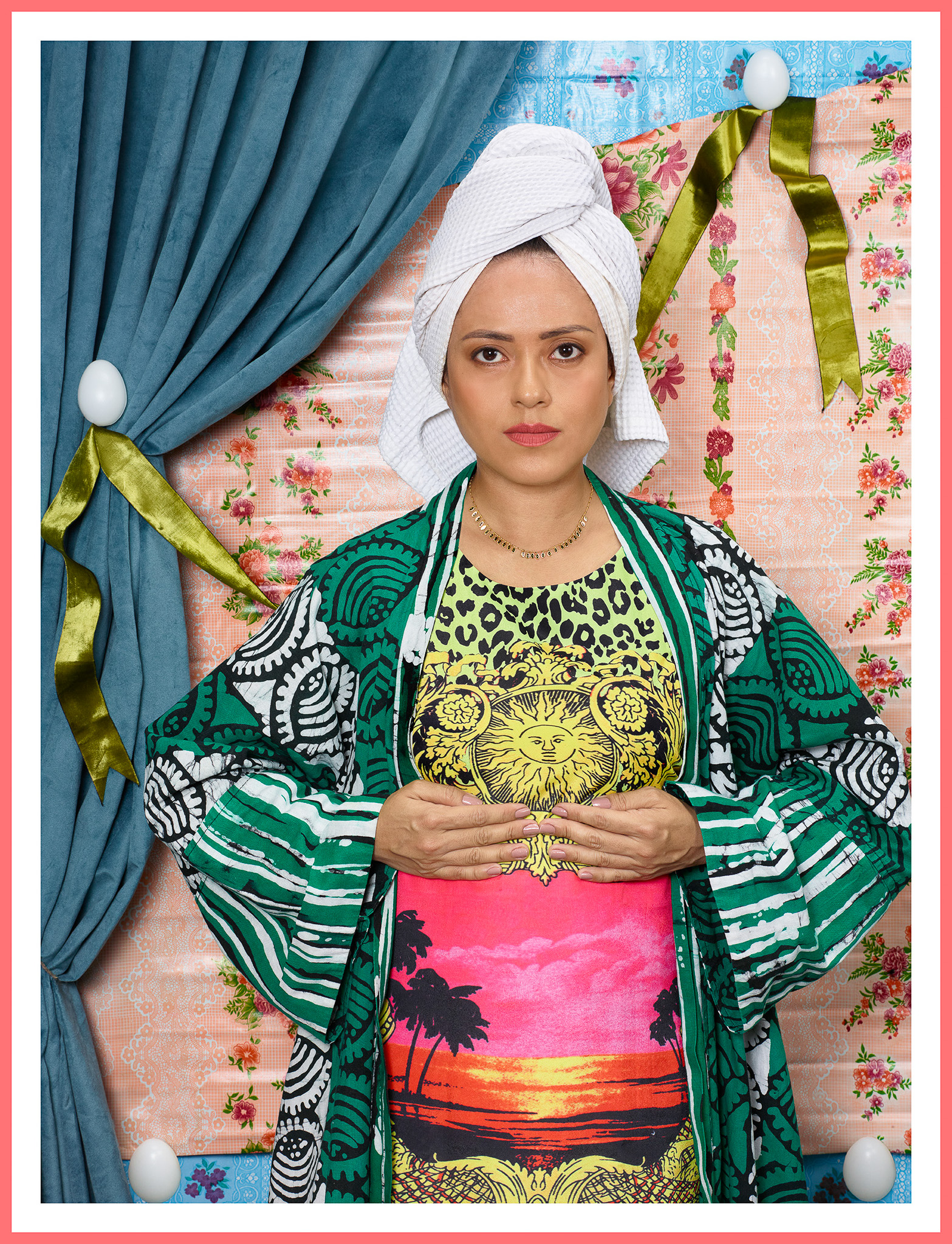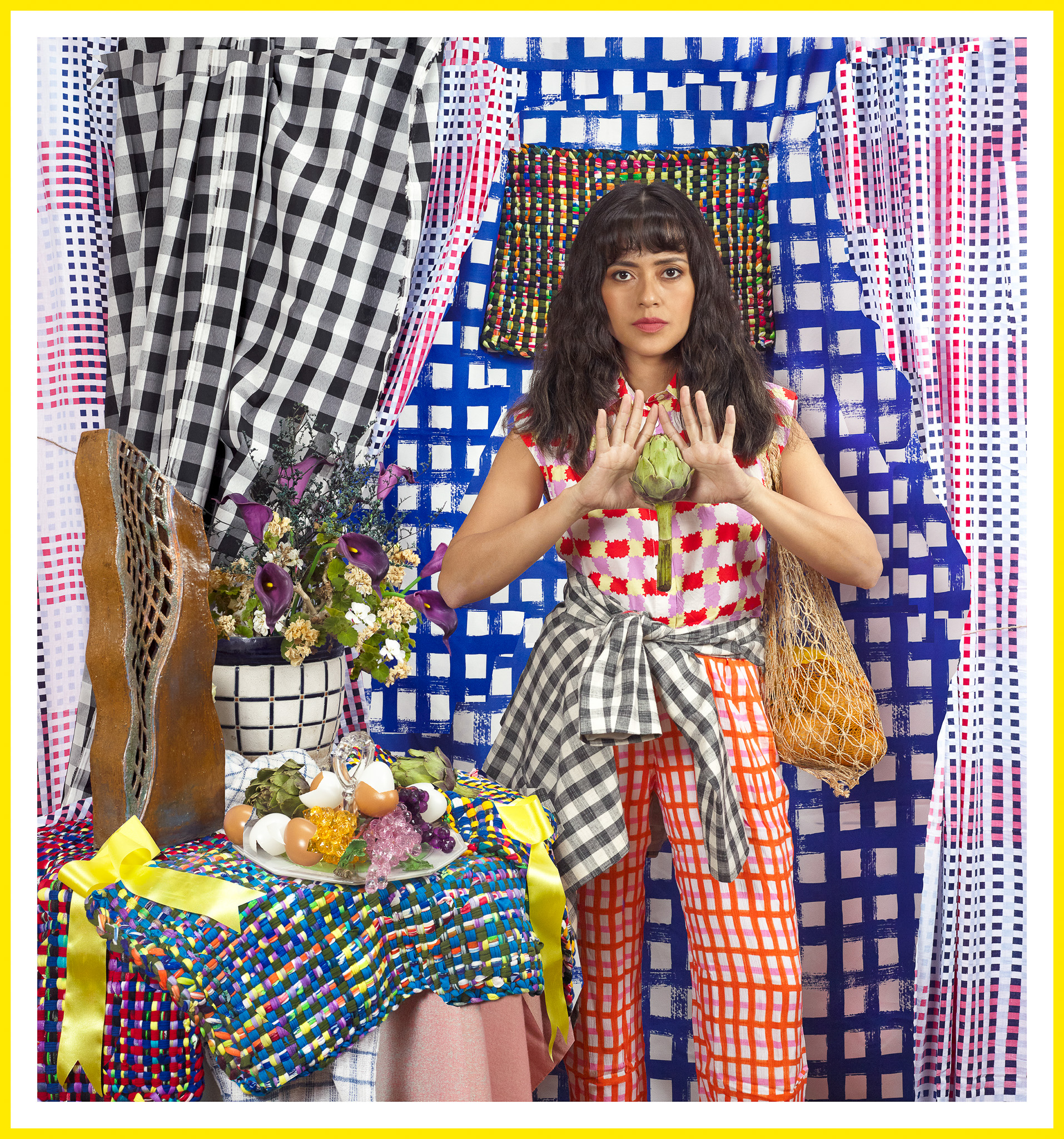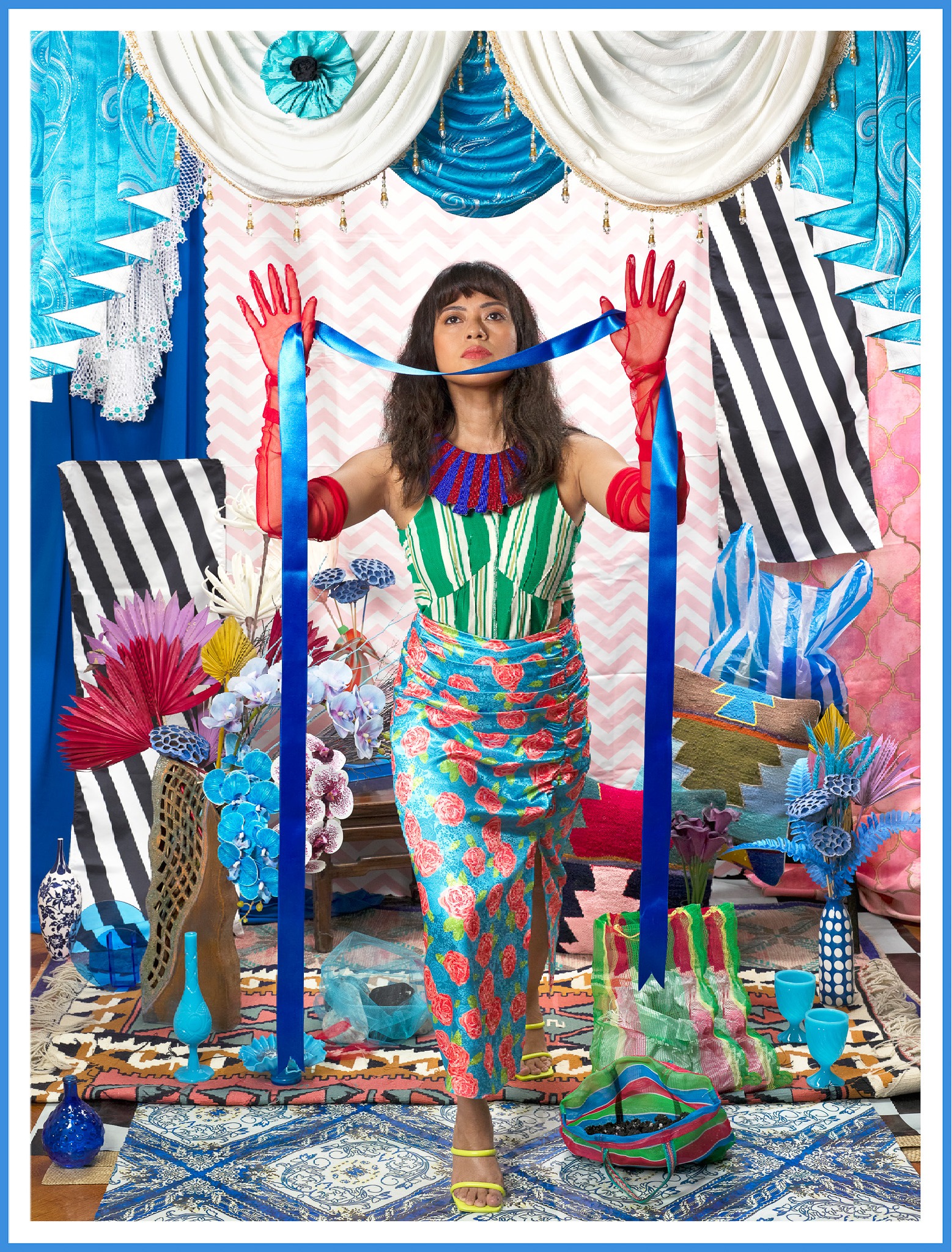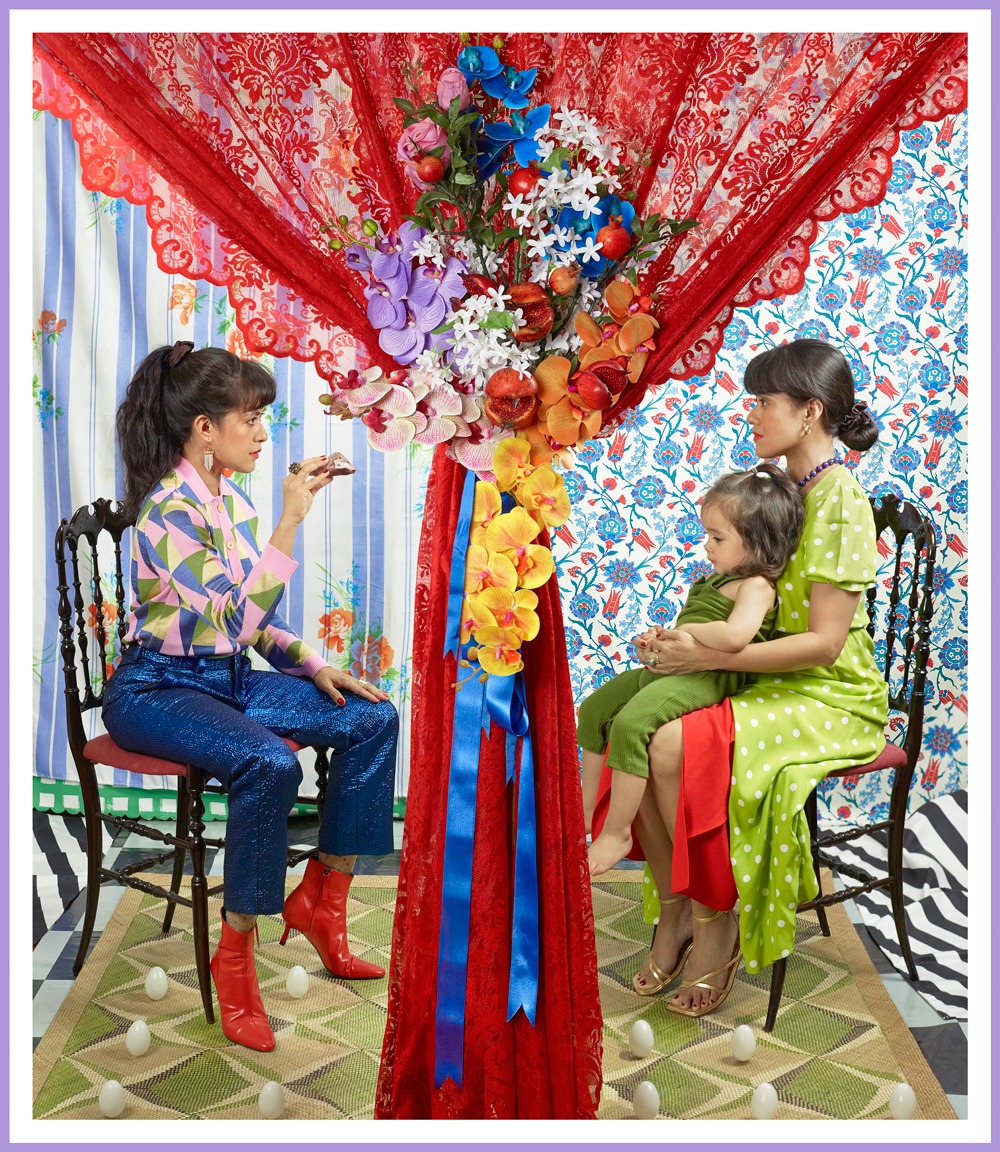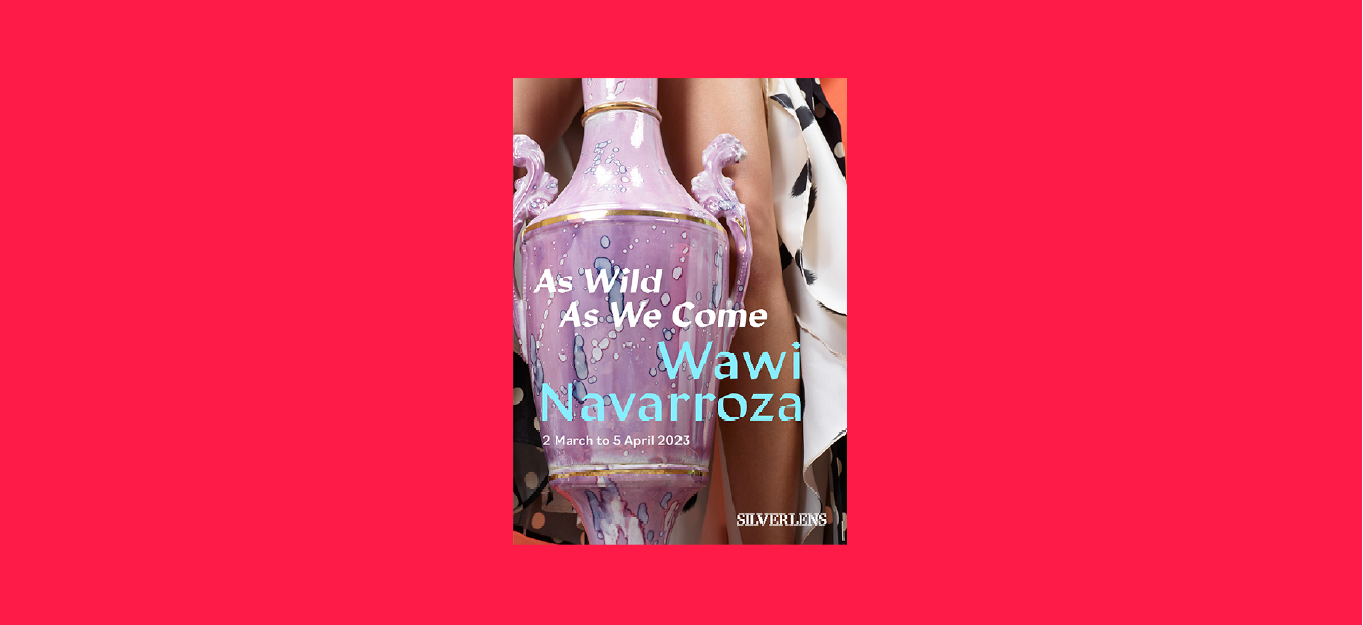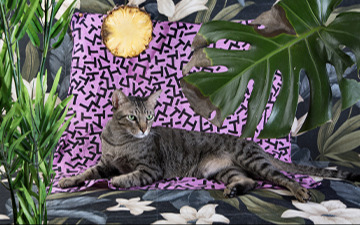
About
Wawi Navarroza enters her new body of work As Wild As We Come via the Wild, subverting its loaded meanings in a dazzling array of symbols, patterns, colours, and the Self. The Wild has preoccupied fantasies of Western artmaking for centuries, opposing the ‘civilised’ sensibilities of the Global North who visually and linguistically illustrated the exotic; take, for example, Henri Rousseau’s Le Rêve (1910) in which he foregrounds a reclining nude, white woman surrounded by tropical forest and exotic animals while the central, almost intelligible, dark-skinned native woman plays a flute. This painting aptly illustrates the West’s fetishist propensity to equate the ‘Wild’ with lush, erotic mystery. However, Navarroza ten photographic tableaus disrupt the canonically Eurocentric origins of the Wild, undermining the specifically biased discourse that continues to suffuse postcolonial mentality. She approaches the Wild dialectically and frenetically, putting its various signifiers and associations – including herself – in simultaneous conversation.
It is this fetishisation for the exotic Other that Navarroza first enters the Wild. She builds upon her previous bodies of work which consider the Tropical Gothic – a term coined by Nick Joaquin to describe a postcolonial investigation of the liminal unknown using irony and exaggeration – with a novel exploration of the Orient, derived from her 2020 move to the East’s literal portal: Istanbul. By introducing culturally specific signifiers of exoticism like the orchids, pearls, and silk kaftan of Mouth of Pearls / Oryental & Overseas (Self-Portrait), the artist co-opts the West’s harmful discourses and annexes them for herself to deconstruct their meanings. Navarroza’s use of photography as medium also subverts the male, colonial gaze; photography allegedly captures ‘objective’ renderings of the subject, but as critic Marian Pastor Roces points out, the first photographs of Filipinos were framed via the coloniser’s gaze of the exotic. Filipinos, as the colonised, have thus inherited the coloniser’s derogatory idea of themselves. The artist’s photographic practice, however, inherently seeks to undermine and unlearn these frameworks.
Navarroza also approaches the Wild through nature, harkening the uncultivated and celestial. Faunae, rocks, and other natural objects proliferate each composition, employing traditional art historical symbolism. Yet, the combination of fake and real plants as seen in New Pleasures, for example, question reality and artifice. They further recall pre-anthropocentric attitudes when humanity and nature existed more harmoniously.
Women – Navarroza’s third portal – in precolonial Philippines also maintained equal power to men; yet patriarchal colonisation facilitated women’s diminished standing in society, equating them with biological inferiority. Through deliberately arranged interiors of décor and fabric, the artist embraces what has become traditionally denigrated to household ‘women’s work’. She places herself within compositions to stand-in for womanhood whilst simultaneously relating to her own specific experiences that include becoming a recent mother – questioning the historically problematic conflation that renders the value of women in their childbearing. Portals / Double-Portrait depicts two versions of the artist: the left’s body language articulates this Navarroza as carefree and wild, wearing red heels and sparkly trousers with hair tied in a loose ponytail; the right shows a more composed, though still confident, artist with a neat bun and her son on her lap. The two (perhaps even three in her son) versions of Navarroza dialogically contemplate one another. In another artwork entitled Todo Lo Que Tengo / Bottomless / Bereket (Self-Portrait with Vessels), Navarroza digitally edits her seated self to hold fragments of various types of vessels from specific cultures of the ancient world, contemporary Philippines, and Turkey; that these vessels, traditionally symbolic of women, are rendered over one another indicate the artist’s own cultural multiplicity; yet the vessel is often overlooked for what it stores – liquid or child. The Spanish title translates to ‘Everything I have’, thus her embrace of these objects, coupled with her contemplative profile, indicate a fraught inquiry into the ontology of women.
These tableaus brim with symbolism and allegory, but there is also, lastly, a Wildness in their aesthetic of excess. Navarroza’s zealous use of colour, pattern, and texture – in addition to the plethora of objects and gestures – as seen in the backdrop of The Shopper / Heart Sutra (Self-Portrait with Artichoke) result in an amalgamation of overwhelming visual and cognitive stimuli that articulate as Postcolonial Camp. The ‘Postcolonial’ preface highlights the necessity of postcolonial agency in engaging with this notion as a method of subversion following over 500 years of subjugation by Spain, America and Japan; ‘Camp’, as described by Susan Sontag in her pioneering text ‘Notes on Camp’, is the victory of style, aesthetics, and irony over content, morality, and tragedy. The artist has admitted to shying away from descriptors such as Kitsch or Camp in the past, preferring instead serious and plainly conceptual modes. However, her realisation of these opinions’ colonial and patriarchal inheritance unlocked her current practice full of vivacity and theatricality, which is no less critically engaged. Countries of the Global South such as the Philippines that have acceded a kitsch mode are particularly susceptible to derogatory condescension regarding taste. Though, capitalist forces of the Global North such as that which precipitated the widespread Filipino migration movement – that Navarroza is a participant of – and Oversees Foreign Worker (OFW) phenomenon are largely responsible for the same aesthetic it derides. These Filipinos often bring back indexes of the cultures in which they found success such as curtain swags or Roman columns that might be called unsophisticated, but in reality reflect a perseverance and resourcefulness that should be celebrated. The Postcolonial Camp thus emerges within contemporary Philippines and Navarroza’s tableaus as an alternative reality filled with creativity, playfulness and substance.
This series’ title As Wild As We Come indicate Navarroza’s intention of maximising the Wild signifier. She has indeed accomplished this, as these photographs brim with a visual lexicon that undermines conventional and destructive meanings of the Other, nature, women, and excess. The artist’s tableaus celebrate what we’ve been conditioned to be ashamed about, embracing the chaos in a cathartic act of joy, play, and sensorial delight.
– Marv Recinto
Wawi Navarroza is a Filipino contemporary artist known for her works in photography, actively exhibiting in galleries and museums in the Philippines and internationally. Her images explore Self and Surrounding as seen in her works in contemporary landscape, constructed tableaus, and self-portraits. Informed by tropicality within the dynamics of post-colonial dialogue, globalization, and the artist as transnational, her works transmute personal experience to the symbolic while probing materials and studio practice; all perhaps to mirror a path to understanding a deeper sense of place & identity.
She has exhibited widely in the Philippines and internationally, including the National Museum of the Philippines, Metropolitan Museum of Manila, Singapore Art Museum 8Q, Hangaram Museum (Korea), National Museum of Fine Arts (Taiwan), Yogyakarta National Museum (Indonesia), Fries Museum of Contemporary Art & Museum Belvedere (Netherlands), Danubiana Museum (Slovakia), and in galleries in Australia, Japan, Malaysia, Singapore, Laos, Cambodia, London, Spain, Italy, and Russia; with continued participation in international photography festivals and art fairs such as Art Basel HK.
Navarroza has received a number of awards such as the Asian Cultural Council Fellowship Grant New York, Lucas Artists Fellowship Award for Visual Arts San Francisco, Cultural Center of the Philippines’ Thirteen Artists Awards, Ateneo Art Awards, Lumi Photographic Art Awards Helsinki, and a finalist for Singapore Museum Signature Art Prize, WMA Commission Hong Kong and Sovereign Asian Art Prize. Her works are in the collection of Bangko Central ng Pilipinas (Central Bank of the Philippines), Metropolitan Museum of the Philippines, Menarco Tower/The Vertical Museum at Bonifacio Global City, and Stora Enso Photography Museum in Oulu, Finland.
Her art has been surveyed in books such as “Photography Today” (Phaidon) “Contemporary Photography in Asia” (Prestel) and “Photography in South East Asia” by Zuang Wubin (NUS Press). Navarroza has been a strong proponent of the printed format as an extension of artistic work and with this, has published two books “DOMINION” and “Hunt & Gather, Terraria”, launched respectively at Offprint Paris and PS1MoMA. In 2015, she founded Thousandfold, a contemporary photography platform, and the first photobook library in Manila, with Thousandfold Small Press as its publishing arm. As an educator, she gives periodic workshops and is a recognized speaker at photography talks, reviews, and conferences in the Philippines and abroad.
Navarroza is a graduate of Communications Arts at De La Salle University, Manila. Shortly after, she received continuing education at the International Center of Photography in New York City with a Fellowship Grant from the Asian Cultural Council. For a few years, she was based in Spain where she finished her Masters in Contemporary Photography (Master Europeo de Fotografía de Autor) awarded by Instituto Europeo di Design in Madrid.
She currently lives and works in İstanbul, Turkey.
Wawi Navarroza is represented by Silverlens and Kristin Hjellegjerde Gallery.
For inquiries: studio@wawinavarroza.com
As Wild As We Come (2022) is a series of self-portraits that mark a resurfacing out of a period of dramatic changes, childbirth and motherhood, while also relocating from Manila to Istanbul, all traversed during the pandemic and a global standstill . This latest collection continues my vivid and layered explorations into identity, place and belonging, with a specific focus on the female experience, rebirth and transformation.
The suite of large format colorful works mark a celebratory return and regeneration through the power of Art-making . She is the Woman at the Threshold; these are her portraits . What is the threshold if not the picture frame, if not a PORTAL to a new life, new place, new time — a woman’s season of change .
I unpack the WILD through many puertas/entries in my works with the WILD as : nature, woman, oriental, other .
Through the embodied self-portraits, I explore and navigate the Tropical Gothic, the “wild wild East”, the wild in Women/Mother/Artist/Creatrix, postcolonial camp, the question of kitsch and “women’s work”, diaspora, transnationality, post-photography, and COLOR .
When I say WE in “As Wild As We Come” I bring with me :
- We as women
- We as artists
- We as mothers
- We as Filipino, Southeast Asians
- We as diasporic/transnationals
- We in the multiplicity and porosity of identity and place
- We in my own multi-faceted Self
And all these experiences lived, sensorially, meaningfully, courageously.
– Wawi Navarroza
Truth be told, photography is not the medium I use — I am . My body is . I just take the camera along for the ride and I’ve intervened in it in every step of the process: from the studio mise en scène with the mix of materials, to the photographic lighting (so that the images look flat as if a collage), to the post-processing (some anomalies like riddles), to the large format print, to the artist frame . I’m making my decisions known . Both playful and precise, unabashedly cacophonous, maxed out in polychrome, the wild wild East in full gallop, embracing folk motif, domestic decor, “women’s work”, DIY, the Philippine tropical gothic horror vacui added with Turkish elaborate ornamentation; the exotic, the handmade, the plastic, the mass-produced, the high-low clatter and clang — I use this visual language as practices to understand and possibly decolonize an interesting tapestry of identity through my lived experience as a woman, artist, Filipina, born and raised in the Philippines, educated in the West, lived in many places, multicultural, transnational, and a new mother (an artist-mother, to be exact). I welcome this contamination/hybridity/syncreticity as points of inquiry and conversation.
In summary, my two-decade art practice has been devoted to deepening my understanding and interpretation of Self and Surrounding with photography as witness and shapeshifting ally, a contemporary tool that is always evolving.
My self-portraits are testaments to amplify women’s voices and interior worlds . My self-portraits are acts of bravery and defiance, with the hope to contribute/balance the prevailing lopsided hegemony of art which is predominantly western and male . My self-portraits don’t just belong to me, it belongs to each woman who has in her first order of desire is to create.
– Wawi Navarroza
Works
